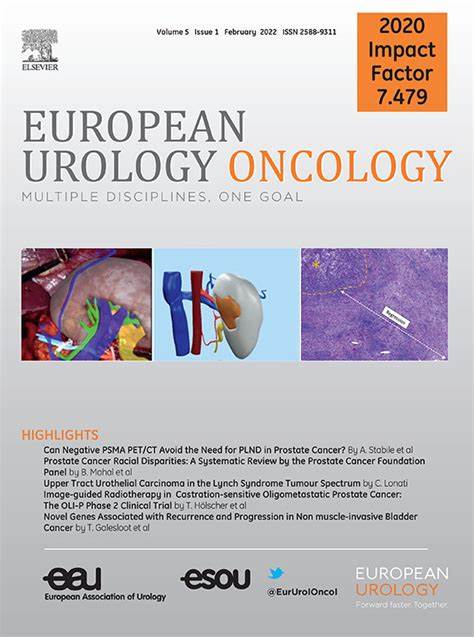Every Other Day or Once a Week: Long-term Oncological Outcomes in the Phase 2 PATRIOT Trial of Prostate Stereotactic Ablative Body Radiotherapy
IF 9.3
1区 医学
Q1 ONCOLOGY
引用次数: 0
Abstract
Background and objective
The PATRIOT multicentre phase 2 trial showed that prolongation of overall treatment time (OTT) for prostate stereotactic ablative body radiotherapy (SABR) was associated with better acute bowel and urinary quality of life. However, the impact on long-term cancer outcomes is unclear.
Methods
Men with favourable-risk localised prostate cancer in the PATRIOT trial were randomised to five-fraction prostate SABR every other day (EOD; n = 77) or once weekly (QW; n = 75).The cancer outcomes evaluated in this post hoc analyses were biochemical failure (BF), metastasis-free survival (MFS), prostate cancer–specific survival (PCSS), and overall survival (OS).
Key findings and limitations
Median follow-up was 91 mo. The 8-yr cumulative incidence rates for BF were 5.5% in the EOD arm versus 9.6% the QW arm (p = 0.2). The 8-yr probability rates were 100% versus 95.9% for MFS (p = 0.08), 100% versus 97.2% for PCSS (p = 0.2), and 96.0% versus 85.4% for OS (p = 0.3) for the EOD versus QW arms, respectively. The study is limited by the small sample size (powered to detect significant differences in acute bowel quality of life).
Conclusions
This study suggests no significant differences in long-term cancer outcomes between EOD and QW schedules for five-fraction prostate SABR.
This trial is registered on ClinicalTrials.gov as NCT01423474.
每隔一天或每周一次:前列腺立体定向消融体放疗的2期爱国者试验的长期肿瘤预后。
背景与目的:PATRIOT多中心二期试验显示,前列腺立体定向消融体放疗(SABR)总治疗时间(OTT)的延长与更好的急性肠和尿生活质量相关。然而,对长期癌症预后的影响尚不清楚。方法:在PATRIOT试验中,有有利风险的局限性前列腺癌的男性被随机分配到每隔一天五段式前列腺SABR (EOD;n = 77)或每周一次(QW;n = 75)。在这个事后分析中评估的癌症结局是生化失败(BF)、无转移生存(MFS)、前列腺癌特异性生存(PCSS)和总生存(OS)。主要发现和局限性:中位随访为91个月。8年累计BF发病率在EOD组为5.5%,而QW组为9.6% (p = 0.2)。8年的概率分别为:MFS组为100% vs 95.9% (p = 0.08), PCSS组为100% vs 97.2% (p = 0.2), EOD组vs QW组为96.0% vs 85.4% (p = 0.3)。该研究受限于样本量小(不足以检测急性肠道生活质量的显著差异)。结论:本研究表明,EOD和QW方案在五段式前列腺SABR的长期癌症预后方面无显著差异。该试验在ClinicalTrials.gov上注册为NCT01423474。
本文章由计算机程序翻译,如有差异,请以英文原文为准。
求助全文
约1分钟内获得全文
求助全文
来源期刊

European urology oncology
Multiple-
CiteScore
15.50
自引率
2.40%
发文量
128
审稿时长
20 days
期刊介绍:
Journal Name: European Urology Oncology
Affiliation: Official Journal of the European Association of Urology
Focus:
First official publication of the EAU fully devoted to the study of genitourinary malignancies
Aims to deliver high-quality research
Content:
Includes original articles, opinion piece editorials, and invited reviews
Covers clinical, basic, and translational research
Publication Frequency: Six times a year in electronic format
 求助内容:
求助内容: 应助结果提醒方式:
应助结果提醒方式:


